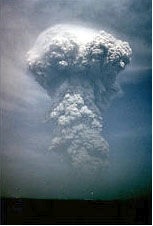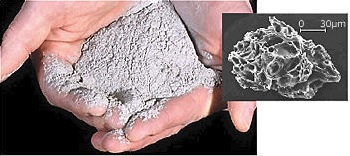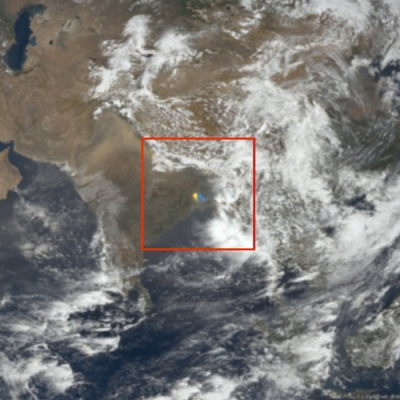When Mount Pinatubo erupted in the Philippines June 15, 1991, an estimated 20 million tons of sulfur dioxide and ash particles blasted more than 12 miles (20 km) high into the atmosphere. The eruption caused widespread destruction and loss of human life. Gases and solids injected into the stratosphere circled the globe for three weeks. Volcanic eruptions of this magnitude can impact global climate, reducing the amount of solar radiation reaching the Earth's surface, lowering temperatures in the troposphere, and changing atmospheric circulation patterns. The extent to which this occurs is an ongoing debate.
Large-scale volcanic activity may last only a few days, but the massive outpouring of gases and ash can influence climate patterns for years. Sulfuric gases convert to sulfate aerosols, sub-micron droplets containing about 75 percent sulfuric acid. Following eruptions, these aerosol particles can linger as long as three to four years in the stratosphere.
Major eruptions alter the Earth's radiative balance because volcanic aerosol clouds absorb terrestrial radiation, and scatter a significant amount of the incoming solar radiation, an effect known as "radiative forcing" that can last from two to three years following a volcanic eruption.
"Volcanic eruptions cause short-term climate changes and contribute to natural climate variability," says Georgiy Stenchikov, a research professor with the Department of Environmental Sciences at Rutgers University. "Exploring effects of volcanic eruption allows us to better understand important physical mechanisms in the climate system that are initiated by volcanic forcing."
Stenchikov and Professor Alan Robock of Rutgers University with Hans Graf and Ingo Kirchner of the Max Planck Institute for Meteorology performed a series of climate simulations that combined volcanic aerosol observations from the Stratospheric Aerosol and Gas Experiment II (SAGE II) available from NASA's Atmospheric Science Data Center (ASDC), with Upper Atmosphere Research Satellite (UARS) data from NASA's Goddard Earth Science Data and Information Services Center (GES DISC).
The research team ran a general circulation model developed at the Max Planck Institute with and without Pinatubo aerosols for the two years following the Pinatubo eruption. To study the sensitivity of climate response to sea surface temperature, using data from NASA's Physical Oceanography Distributed Active Archive Center (PO.DAAC), they conducted calculations with climatologically mean sea surface temperature, as well as with those observed during particular El Niño and La Niña periods.
By comparing the climate simulations from the Pinatubo eruption, with and without aerosols, the researchers found that the climate model calculated a general cooling of the global troposphere, but yielded a clear winter warming pattern of surface air temperature over Northern Hemisphere continents. The temperature of the tropical lower stratosphere increased by 4 Kelvin (4°C) because of aerosol absorption of terrestrial longwave and solar near-infrared radiation. The model demonstrated that the direct radiative effect of volcanic aerosols causes general stratospheric heating and tropospheric cooling, with a tropospheric warming pattern in the winter.
"The modeled temperature change is consistent with the temperature anomalies observed after the eruption," Stenchikov says. "The pattern of winter warming following the volcanic eruption is practically identical to a pattern of winter surface temperature change caused by global warming. It shows that volcanic aerosols force fundamental climate mechanisms that play an important role in the global change process."
This temperature pattern is consistent with the existence of a strong phase of the Arctic Oscillation, a natural pattern of circulation in which atmospheric pressure at polar and middle latitudes fluctuates, bringing higher-than-normal pressure over the polar region and lower-than-normal pressure at about 45 degrees north latitude. It is forced by the aerosol radiative effect, and circulation in winter is stronger than the aerosol radiative cooling that dominates in summer.
Man-made, or "anthropogenic" emissions can make the consequences of volcanic eruptions on the global climate system more severe, Stenchikov says. For instance, chlorofluorocarbons (CFCs) in the atmosphere start a chain of chemical reactions on aerosol surfaces that destroy ozone molecules in the mid-latitude stratosphere, intensifying observed stratospheric ozone depletion.
"While we have no observations, the 1963 Agung eruption on the island of Bali probably did not deplete ozone as there was little atmospheric chlorine in the stratosphere. In 1991 after the Pinatubo eruption, when the amount of CFCs in the stratosphere increased, the ozone content in the mid-latitudes decreased by 5 percent to 8 percent, affecting highly populated regions," says Stenchikov.
NASA and the National Science Foundation have funded Robock and Stenchikov to study the Pinatubo eruption in more detail, and to conduct another model comparison with the volcanic aerosol data set. They plan to combine SAGE II data with available lidar and satellite data from various DAACs to improve their existing data set.
By understanding the impact of large volcanic eruptions on Earth's climate system in more detail, perhaps scientists will be in a better position to suggest measures to lessen their effects on people and natural resources.
References
Kirchner, I., G. Stenchikov, H.-F. Graf, A. Robock. J. Antuna, Climate model simulation of winter warming and summer cooling following the 1991 Mount Pinatubo volcanic eruption, J. Geophys. Res., 104, 19,039-19,055, 1999.
Stenchikov, Georgiy L., Ingo Kirchner, Alan Robock, Hans-F. Graf, Juan Carlos Antuna, R. G. Grainger, Alyn Lambert, and Larry Thomason, 1998: Radiative Forcing from the 1991 Mount Pinatubo volcanic eruption. J. Geophys Res.103(D12), pp. 13837-13857.
For more information
NASA Atmospheric Science Data Center (ASDC)
NASA Goddard Earth Sciences Data and Information Services Center (GES DISC)
NASA Physical Oceanography Distributed Active Archive Center (PO.DAAC)
| About the remote sensing data used | |||
|---|---|---|---|
| Satellite | Stratospheric Aerosol and Gas Experiment II (SAGE II) | Upper Atmosphere Research Satellite (UARS) | NOAA -7, -9, -11, and -14 polar orbiting satellites |
| Sensor | Advanced Very High Resolution Radiometers (AVHRR) | ||
| Parameter | volcanic aerosols and climate change | volcanic aerosols and climate change | volcanic aerosols and climate change |
| DAAC | NASA Atmospheric Science Data Center (ASDC) | NASA Goddard Earth Sciences Data and Information Services Center (GES DISC) | NASA Physical Oceanography Distributed Active Archive Center (PO.DAAC) |



